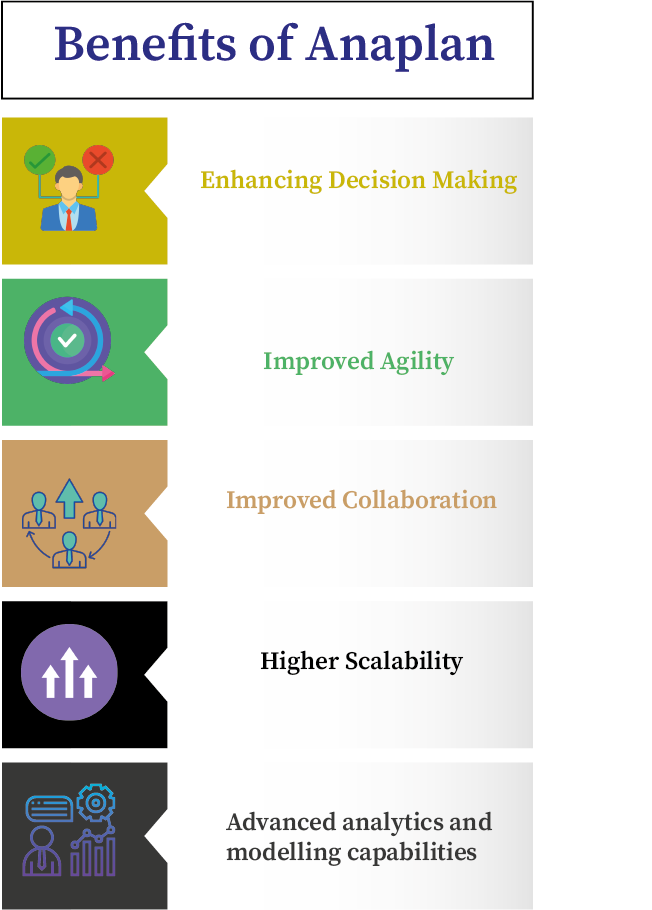Anaplan Training | Learn Anaplan Course
What Is Anaplan?
Anaplan is a cloud-based solution designed for company planning and performance management. It offers flexible features for real-time modelling, evaluating, and improving business processes.
It empowers enterprises by seamlessly connecting data, people, and plans across workplace locations, allowing faster decision-making with improved decisions made faster by users.
Its platform, powered by an in-memory data engine, is capable of creating complex models and performing large-scale computations and is designed with a user-friendly interface. This interface enables non-technical users to quickly generate or alter models while communicating in real-time with others on the platform.
With its wide range of applications, Anaplan can be a valuable tool for businesses in various company planning and performance management activities. These include financial analysis and planning, sales and operations planning, labour scheduling, and supply chain planning. Its prebuilt interfaces also make it easy for businesses to incorporate data from various systems into their models.
Anaplan distinguishes itself by offering flexible planning procedures. Unlike traditional systems that demand significant time and effort for adjustments, Anaplan’s platform allows customers to swiftly and efficiently modify their models, adapting promptly to changing business circumstances in real time, relieving the burden of complex planning tasks.
It offers advanced analytics and modelling capabilities, such as predictive forecasting, scenario modelling, and decision optimisation. These services empower businesses to plan strategically for the future and assess possible ramifications from any proposed actions, instilling confidence in their decision-making process.
Anaplan is an adaptable, robust solution that may assist firms in enhancing their business planning and performance management procedures. Its single platform for connecting data, people, and plans enables enterprises to make quicker, smarter choices that create improved business results faster.

Prerequisites of Learning Anaplan Course
Understanding of business planning and performance management principles: Before beginning with Anaplan, it is crucial that users possess a sound understanding of business planning and performance management concepts like budgeting, forecasting, and variance analysis. This will make it easier to identify how Anaplan could support such tasks.
Proficient with spreadsheet software: Its user interface resembles a spreadsheet program like Microsoft Excel. Therefore, previous experience using spreadsheet software like this will simplify navigating this technology and learning to build models and calculate results more efficiently.
Firm grasp of data modelling concepts: It provides a platform for creating data models, so understanding key data modelling concepts like data types, associations, and hierarchies is invaluable to developing more successful Anaplan models.
Proficient with relational databases: Understanding relational databases such as Anaplan is helpful since their data resides within them. Understanding their principles, such as tables, rows, and columns, will assist with managing the information stored within them.
Knowledge of basic financial principles: Anaplan offers many apps geared to financial planning and analysis, so a basic understanding of economic principles such as income statements, balance sheets, and cash flow statements will make Anaplan easier to use for planning. By understanding them fully, users can use Anaplan more efficiently for financial analysis.
Benefits of Anaplan Training
Enhancing decision-making processes: It stands out among business applications because it facilitates better decision-making. Businesses use Anaplan as a streamlined, unified platform that quickly connects data, people, and plans.
This allows users to rapidly evaluate data from various sources while making choices based on an accurate picture of their organisation’s structure and dynamics. Anaplan is an indispensable decision-making aid.
Improved Agility: Another significant advantage is that it helps organisations perform agile planning procedures. Adjustments made using traditional planning systems often take excessive time and effort. In contrast, Anaplan enables customers to rapidly and effortlessly modify models on its platform for real-time response to changing business situations.
Improved collaboration: Its collaborative platform facilitates enhanced teamwork. With shared workspaces, commenting/annotation tools and version control, which enables firms to break silos while working towards common objectives more efficiently. It makes team collaboration more efficient than ever.
Higher Scalability: Anaplan’s flexible architecture was explicitly created to deal with large data volumes, making it capable of meeting the planning and performance management demands of enterprises of any size. This is in contrast to typical planning systems, which may only have limited capacity to manage large volumes of information.
Advanced analytics and modelling capabilities: It offers advanced analytics and modelling features, such as predictive forecasting, scenario modelling, and decision optimisation capabilities, that enable businesses to not only plan for the future but also evaluate the possible consequences of various actions they might take and select the optimal course of action.


Anaplan Training

Anaplan Tutorial
Upland Model Overview
The Upland model covers dimensions, time, dashboards, modules, lists, fiscal year settings, forecasting strategies, and data visualisation techniques such as PowerPoint or PDF formats.
Data Forecasting and Lists
Upland Model Calendar data forecasting and lists are discussed as tools for data management, emphasising their importance as tools of geospatial, product, and staff hierarchy lists.
Integration and System Setup
Anaplan can be linked with various data processing tools before uploading the results onto its plan. In addition, data uploads may occur for the geo hierarchy management and visualisation modules.
Naming Conventions and Manual List Addition
Naming conventions such as geographical or product hierarchies may help improve organisational clarity. A complete instructional list added to a model guides participants through this process using Anaplan’s settings page.
Deleting a List
Anaplan provides users with a convenient method for deleting their desired lists using their mouse or touchpad. They select the list and click the delete option above it. A dialogue box will appear to confirm their decision before prompting users to click OK if they are satisfied.
Create a Hierarchy List
Users are guided in assigning parental hierarchies for every list item by creating columns like location, nation, and product family and assigning parents using drop-down menus or typing. Naming Conventions and Data Management.
Naming Conventions and Data Management
Labelling list items clearly and comprehensibly to facilitate clarity for all users is strongly encouraged to foster clarity and understanding among everyone within a model. For instance, items can be made more readable by being labelled with concise names, such as HR, rather than “Human Resources”.
Assigning Top-Level Settings
Implementing top-level settings involves two approaches. One consists of selecting an appropriate list and editing its settings via the general list tab, while a confirmation process must be undertaken before making any alterations. Top-level characteristics must be present for efficient data summarisation and hierarchical organisation.
Import Lists and Manage Data
It provides users with steps for importing lists and data into Excel models. It requires them to create lists in the model before matching source and destination sources during import, choosing an appropriate data type, mapping/crosschecking for successful import, etc.
Grid Water testing and time management
To conduct the top-level grid water test in Anaplan, import a CSV file and match its source files with plan target files. Proper mapping involves identifying text encoding, column separators, and header rows, along with time management; the user must agree to modify working hours as commitments arise.

Anaplan Online Training

Modes for Learning Anaplan Course
Self-Paced
Self-paced learning makes Anaplan training accessible, allowing learners to progress quickly through each subject area and create autonomous study. For Anaplan online training, learners can access various learning resources, such as video lessons, simulations, and self-assessment quizzes.
Self-paced Anaplan training accommodates a range of learning styles and schedules, giving learners access to complex topics or quickly revisit familiar ones as needed.
Learners have more control over their experience by customising it around their interests and educational goals. Plus, Anaplan online course instruction often gives access to documentation or community forums that offer peer assistance while offering opportunities for collaboration among them.
Instructor-led live training
Instructor-led live Anaplan classes provide participants with a structured yet engaging learning environment led by expert instructors. Real-time discussions, demonstrations, and collaborative activities are needed to better comprehend and utilise Anaplan technology.
This learning approach for the Anaplan course gives learners access to immediate instructor feedback. Questions are raised when necessary and answered immediately, ultimately leading them to better comprehend complex ideas and functionality.
For Anaplan online classes, Instructors often incorporate real-life examples and case studies into their curriculums to demonstrate practical applications, best practices and real-world issues.
The Anaplan online course’s hands-on activities allow learners to apply theoretical knowledge practically under realistic circumstances, providing invaluable practice before facing real-world matters themselves.
Instructor-led Anaplan online training fosters peer learning by connecting learners to industry experts and peers. This results in an interactive learning experience with industry experts and fellow learners, creating an enriching academic journey for all involved.
 Anaplan Certification
Anaplan Certification
Anaplan Certification allows individuals to demonstrate their ability to use Anaplan’s platform for planning and decision-making. The program includes numerous certificates designed to certify specific skills or capacities.
Anaplan Model Builder Certification: This certification recognises those who create and manage Anaplan models. It verifies their abilities to create complex models, increase performance, and verify data quality.
Anaplan Solution Architect Certification: It recognises those who develop and execute Anaplan solutions, validating their ability to design scalable and sustainable solutions that fulfil corporate goals while effectively working with stakeholders.
Anaplan Master Anaplanner Certification: This certification is the highest level available to experts using Anaplan’s platform. It is intended for those who demonstrate exceptional proficiency at using it to address complex business problems with ease. Learners for this designation must pass an in-depth test covering topics like data integration, model optimisation, and solution design before receiving this award.
Overall, the Anaplan Certification program offers professionals an effective means of demonstrating mastery over its planning and decision-making platform. Earning one or more certificates may assist them with furthering their careers, increasing earnings potential, or becoming authorities within their fields.

Anaplan Course Price


Ravi
Author
 Anaplan Certification
Anaplan Certification